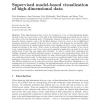Free Online Productivity Tools
i2Speak
i2Symbol
i2OCR
iTex2Img
iWeb2Print
iWeb2Shot
i2Type
iPdf2Split
iPdf2Merge
i2Bopomofo
i2Arabic
i2Style
i2Image
i2PDF
iLatex2Rtf
Sci2ools
120
Voted
IDA
2000
Springer
2000
Springer
Supervised model-based visualization of high-dimensional data
When high-dimensional data vectors are visualized on a two- or three-dimensional display, the goal is that two vectors close to each other in the multi-dimensional space should also be close to each other in the low-dimensional space. Traditionally, closeness is defined in terms of some standard geometric distance measure, such as the Euclidean distance, based on a more or less straightforward comparison between the contents of the data vectors. However, such distances do not generally reflect properly the properties of complex problem domains, where changing one bit in a vector may completely change the relevance of the vector. What is more, in real-world situations the similarity of two vectors is not a universal property: even if two vectors can be regarded as similar from one point of view, from another point of view they may appear quite dissimilar. In order to capture these requirements for building a pragmatic and flexible similarity measure, we propose a data visualization sche...
Bayesian Network Model | Data Vectors | Geometric Distance Measure | IDA 2000 | Information Technology |
Related Content
| Added | 18 Dec 2010 |
| Updated | 18 Dec 2010 |
| Type | Journal |
| Year | 2000 |
| Where | IDA |
| Authors | Petri Kontkanen, Jussi Lahtinen, Petri Myllymäki, Tomi Silander, Henry Tirri |
Comments (0)

